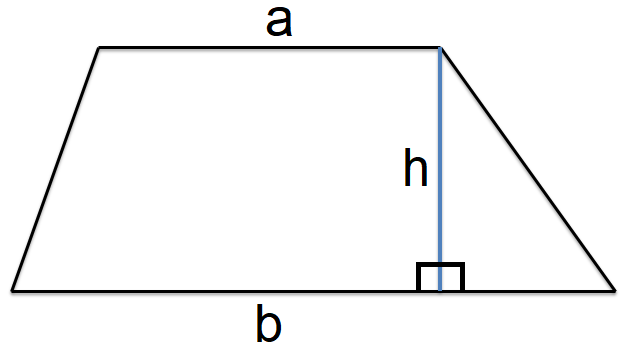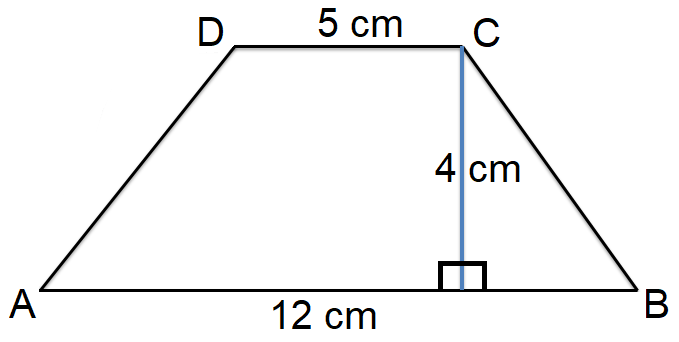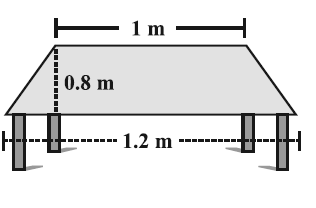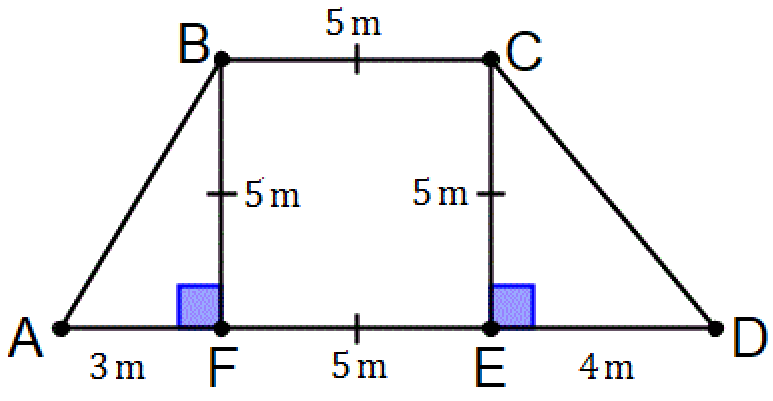AREA OF TRAPEZIUM
Subscribe to our ▶️ YouTube channel 🔴 for the latest videos, updates, and tips.
Definition of Trapezium :
The definition of trapezium is entirely different in both US and UK.
- In US, a quadrilateral which is having no parallel sides is called trapezium.
- But in UK, a quadrilateral which is having one pair of parallel sides is called trapezium.
Definition of Trapezoid :
- In UK, a quadrilateral which is having no parallel sides is called trapezoid.
- But in US, a quadrilateral which is having one pair of parallel sides is called trapezoid.

In the trapezium / trapezoid above, 'a' and 'b' are the lengths of the parallel sides and 'h' is the height.
Formula to Find Area of Trapezium / Trapezoid :
A = (1/2)(a + b)h
Examples
Example 1 :
Find the area of the trapezium ABCD shown below.

Solution :
Area of trapezium = (1/2)(a + b)h
Substitute a = 5, b = 12 and h = 4.
= (1/2)(5 + 12)4
= (1/2)(17)4
= 34 cm2
Example 2 :
In a trapezium the measurement of one parallel side two more than the other parallel side and the height is 4 cm. The area of the trapezium is 64 cm2. Find the lengths of the two parallel sides.
Solution :
Let 'a' and 'b' be the two parallel sides.
One parallel side is two more than the other parallel side.
Then,
a = b + 2
Area of the trapezium = 64 cm2
(1/2)(a + b)h = 64
Substitute h = 4 and a = b + 2.
(1/2)(b + 2 + a)4 = 64
(2b + 2)2 = 64
Divide each side by 2.
2b + 2 = 32
Subtract 2 from each side.
2b = 30
Divide each side by 2.
b = 15
Then,
a = b + 2
a = 15 + 2
a = 17
So, the lengths of the two parallel sides are 15 cm and 17 cm.
Example 3 :
The shape of the top surface of a table is a trapezium. Find its area, if its parallel sides are 1 m and 1.2 m and perpendicular distance between 0.8 m.

Solution :
Area of a the top of surface of the table (trapezium) is
= (1/2)(a + b)h
= (1/2)(1.2 + 1)0.8
= (1/2) (2.2)0.8
= 1.1 (0.8)
= 8.8 m2
Example 4 :
The wall is in the shape as shown below has to be painted. If one can of paint covers 0.5 m2, how many cans of paint will be needed, if only one coat of paint is applied ?

Solution :
In the figure shown above, the perpendicular distance between the two sides BC and AB at any point is same, which is 5 cm.
Then, the sides BC and AD are parallel.
In the quadrilateral above, because the two sides BC and AD are parallel, ABCD is a trapezium.
Let 'a' and 'b' be the lengths of two parallel sides and.
a = BC = 5cm
b = AD = AF + FE + ED = 3 + 5 + 4 = 12 cm
Height (h) = 5 cm
Area of the trapezium ABCD is
= (1/2)(a + b)h
Substitute a = 5, b = 12 and h = 5.
= (1/2)(5 + 12)5
= 42.5 m2
One can of paint covers 0.5 m2.
Number of cans of paint required 42.5 m2 is
= 42.5 / 0.5
= 425 / 5
= 85
So, 85 cans of paint required to cover the above wall.
Example 4 :
The two parallel sides of a trapezium are 1.5 m and 2.5 m respectively. If the perpendicular distance between them is 6.5 meters, the area of the trapezium is :
a) 10 m2 b) 13 m2 c) 20 m2 d) 26 m2
Solution :
Length of parallel sides, a = 1.5 m and b = 2.5 m
height = 6.5 m
Area of trapezium = (1/2)(a + b)h
= (1/2) x 6.5 (1.5 + 2.5)
= (1/2) x 6.5 x 4
= 2 x 6.5
= 13 m2
So, option b is correct.
Example 5 :
The area of the field in the shape of trapezium measures 1440 m2. The perpendicular distance between its parallel sides is 24 m. If the ratio of the parallel sides is 5 : 3 the length of the longer parallel side is :
a) 45 m b) 60 m c) 75 m d) 120 m
Solution :
Area of trapezium = 1440 m2
height = 24 m
Let 5x and 3x be the length of parallel sides.
(1/2)(a + b)h = 1440
(1/2)(5x + 3x)24 = 1440
12(8x) = 1440
x = 1440/12 x 8)
x = 15
3x = 3(15) ==> 45 m
5x = 5(15) ==> 75 m
So, the length of longer parallel side is 75 m.
Example 6 :
The cross section of a canal is trapezium in shape. The canal is 12 m wide at the top and 8 m wide at the bottom. If the area of the cross The area of the cross section is 840 sq.cm the depth of the canal is :
a) 8.75 m b) 42 m c) 63 m d) 84 m
Solution :
Length of parallel sides, a = 12 m, b = 8 m
Area of the cross section = 840 sq.cm
Let h be the depth of trapezium.
(1/2) h (12 + 8) = 840
(1/2) x h(20) = 840
10h = 840
h = 840/10
h = 84 cm
Subscribe to our ▶️ YouTube channel 🔴 for the latest videos, updates, and tips.
Kindly mail your feedback to v4formath@gmail.com
We always appreciate your feedback.
About Us | Contact Us | Privacy Policy
©All rights reserved. onlinemath4all.com
Recent Articles
-
Quantitative Reasoning Questions and Answers
Dec 14, 25 06:42 AM
Quantitative Reasoning Questions and Answers -
Specifying Units of Measure
Dec 14, 25 06:38 AM
Specifying Units of Measure -
Coin Tossing Probability
Dec 13, 25 10:11 AM
Coin Tossing Probability - Concept - Sample Space - Formula - Solved Problems